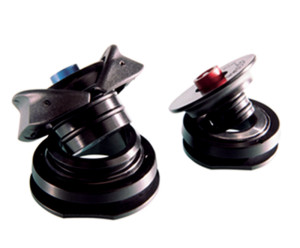Horseshoe shape is luckiest for hips
In a study comparing hip protector products, Hipsaver’s 16 mm thick continuous pad provided the greatest reduction in peak force to the hip, but the SafeHip 16 mm horseshoe-shaped pad most effectively deflected force away from the so-called “danger zone.”
Researchers from Simon Fraser University in British Columbia compared three hip protector products using a hip impact simulator that replicated the effects of a fall on the hip joint. The continuous pad from Canton, MA-based Hipsaver was compared to two SafeHip horseshoe-shaped pads of different thicknesses from Lincoln, RI-based Tytex.
For a 20-cm drop, the Hipsaver reduced peak pressure by 88% compared to an unpadded condition, while the 16-mm SafeHip demonstrated an 83% reduction and the 14-mm SafeHip a 78% reduction. In terms of force specifically on the greater trochanter, however, the 16-mm SafeHip lowered force by 45%, compared to 38% for the 14-mm SafeHip and 30% for the Hipsaver. The area comprising the greater trochanter and femoral diaphysis is known as the “danger zone,” because a high percentage of hip fractures in the elderly involve an impact to this area.
The findings, presented in August at the annual meeting of the American Society of Biomechanics, also indicated that all three devices were most effective when centered over the greater trochanter—underscoring the importance of keeping them held in place. The hip protectors’ effectiveness decreased significantly as they migrated, with 5 cm of displacement associated with 29% less protection than the centered position.
 Otto Bock valves earn design award
Otto Bock valves earn design award
Otto Bock Healthcare received a Red Dot Design Award this summer for the threadless design of two of its prosthetic valves, the third consecutive year that the Dunderstadt, Germany-based company has won a Red Dot award.
The product design component of the prestigious competition attracted more than 3000 entries in categories ranging from furniture to jewelry to automobiles. Otto Bock’s 21Y14 PushValve, for transfemoral amputees, and the 21Y15 MagValve, for knee disarticulation and upper extremity amputees, won in the “life science and medicine” category. Neither valve requires any screwing or turning movements, which makes them particularly well suited for the elderly or those with limited finger mobility.
Knee OA patients respond to WBV
A 10 minute session on a Power Plate (Irvine, CA) whole body vibration platform was associated with significant improvements on the step test in a University of Florida study of patients with symptomatic knee osteoarthritis.
The 17 patients each stood on a Power Plate Personal vibration platform with knees slightly flexed for 10 one-minute intervals, with one minute of rest between each one. The platform was set for 35 Hz and 4-6 mm displacement.
Before and after the vibration intervention, the subjects completed three functional tests: the timed-up-and-go test, step test and 20-meter walk test. The average time to complete the step test at five minutes after WBV was improved significantly from baseline, and that improvement was maintained at one hour after the intervention. The WBV session was not associated with any significant changes on either of the other two functional tests. The results were presented in August at the annual ASB meeting.
Pain levels also did not change significantly following the intervention, which suggests that the effect on the step test was neuromuscular in nature. However, pain levels had decreased by 28% at the five-minute mark, which despite not being a statistically significant change could still have contributed to the improvement.
DVD-CD package talks the Foot Talk
“Foot Talk,” a new multimedia educational product from Progressive GaitWays (Telluride, CO) features a two-hour lecture on functional foot anatomy and joint biomechanics by physical therapist and company founder Beverly Cusick, PT, MS, COF.
The package includes the lecture, seen in four parts on a DVD, and an accompanying CD with a PDF file of the slide presentation and a supplementary list of current, topic-specific references. The lecture is intended to bring the clarity of plane-based nomenclature to functional foot anatomy and joint motions, and relate foot function to body weight load distribution and to energy efficiency in gait.
Cusick is a pediatric physical therapist specializing in lower extremity deformity, particularly in children with cerebral palsy and other central nervous system deficits. She is also an associate professor in the pediatrics program at the Rocky Mountain University of Health Professions and inventor of TheraTogs orthotic garments.
For more information, visit www.gaitways.com.








